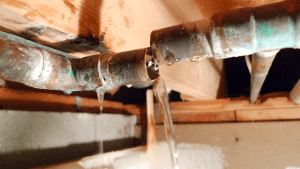6 Ways to Locate Surprise Water Leaks in Your Home
6 Ways to Locate Surprise Water Leaks in Your Home
Blog Article
They are making a number of good points about Leaking water lines in general in this article following next.

Early detection of dripping water lines can reduce a potential disaster. Apart from conserving you money, it will certainly minimize the stress and frustration. The moment you find a leak, calling your plumber for repair services is the best service. Some little water leaks may not be noticeable. Here are some hacks that assist if you can not detect it with your nude eyes.
1. Check Out the Water Meter
Checking it is a proven way that helps you find leakages. If it relocates, that indicates a fast-moving leak. This suggests you might have a slow leak that might also be underground.
2. Check Water Intake
Analyze your water expenses and track your water consumption. As the one paying it, you should notice if there are any disparities. If you identify sudden changes, despite your intake being the same, it means that you have leakages in your plumbing system. Keep in mind, your water expense must fall under the very same array on a monthly basis. An abrupt spike in your costs shows a fast-moving leakage.
On the other hand, a stable boost monthly, despite having the exact same behaviors, shows you have a slow leakage that's also slowly escalating. Call a plumber to completely check your residential property, particularly if you feel a cozy location on your flooring with piping beneath.
3. Do a Food Coloring Examination
When it comes to water intake, 30% comes from bathrooms. If the color somehow infiltrates your dish throughout that time without flushing, there's a leakage in between the container and bowl.
4. Asses Exterior Lines
Don't fail to remember to check your exterior water lines as well. Needs to water seep out of the connection, you have a loosened rubber gasket. One tiny leakage can throw away lots of water and also spike your water bill.
5. Analyze the circumstance and also inspect
Home owners should make it a routine to examine under the sink counters and also inside closets for any bad odor or mold growth. These two red flags suggest a leakage so prompt interest is needed. Doing regular inspections, even bi-annually, can save you from a major issue.
Examine for stainings and compromising as many devices as well as pipes have a life expectancy. If you suspect dripping water lines in your plumbing system, do not wait for it to intensify.
Early detection of dripping water lines can minimize a prospective disaster. Some tiny water leaks may not be visible. Checking it is a proven method that aids you find leaks. One little leakage can squander loads of water and spike your water costs.
If you suspect dripping water lines in your plumbing system, don't wait for it to escalate.
WARNING SIGNS OF WATER LEAKAGE BEHIND THE WALL
PERSISTENT MUSTY ODORS
As water slowly drips from a leaky pipe inside the wall, flooring and sheetrock stay damp and develop an odor similar to wet cardboard. It generates a musty smell that can help you find hidden leaks.
MOLD IN UNUSUAL AREAS
Mold usually grows in wet areas like kitchens, baths and laundry rooms. If you spot the stuff on walls or baseboards in other rooms of the house, it’s a good indicator of undetected water leaks.
STAINS THAT GROW
When mold thrives around a leaky pipe, it sometimes takes hold on the inside surface of the affected wall. A growing stain on otherwise clean sheetrock is often your sign of a hidden plumbing problem.
PEELING OR BUBBLING WALLPAPER / PAINT
This clue is easy to miss in rooms that don’t get much use. When you see wallpaper separating along seams or paint bubbling or flaking off the wall, blame sheetrock that stays wet because of an undetected leak.
BUCKLED CEILINGS AND STAINED FLOORS
If ceilings or floors in bathrooms, kitchens or laundry areas develop structural problems, don’t rule out constant damp inside the walls. Wet sheetrock can affect adjacent framing, flooring and ceilings.
https://www.servicemasterbyzaba.com/blog/how-to-detect-water-leakage-in-walls/

Hopefully you enjoyed reading our section about Detecting hidden plumbing leaks. Thanks a ton for taking the time to browse our short article. Enjoyed reading our write up? Please share it. Let other people find it. Kudos for your time. Kindly stop by our website back soon.
Report this page